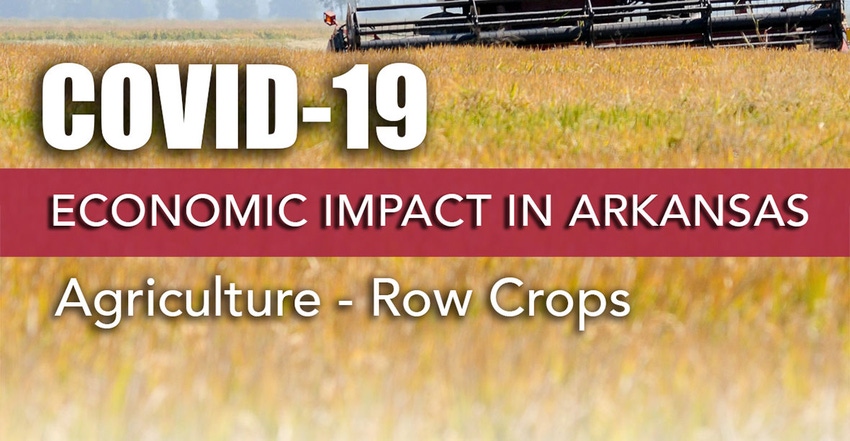April 7, 2020

Arkansas agriculture and the state’s rural areas may face the potential for significant disruption in supply chain, labor and government services due to the effects of the COVID-19 pandemic, according to a multi-sector economic impact released by the University of Arkansas System Division of Agriculture.
The 15-page report, released Friday, provides an overview of potential impacts to agriculture’s protein sector, including beef, pork and chicken; its row and field crops sector; the specialty crop sector, including fruits and food sold across local foods networks; as well as stresses being faced by county and municipal governments and the tourism industry. The full report is available at https://www.uaex.edu/COVID-Ark-Economy.
“Arkansas is highly reliant on agriculture – a functional food supply chain in these times is critical and agriculture is very important to the state’s economy with about a sixth of its economy depending on this sector,” said Mark Cochran, vice president-agriculture for the University of Arkansas System. “We needed to quickly assess the potential impacts all around as the state grapples with this pandemic.
“It’s important to note that this is a first installment,” he said. “We will continue to analyze the situation and provide timely reports from this highly experienced team.”
The report was prepared by the Agricultural Economics and Agribusiness faculty of the University of Arkansas System Division of Agriculture: John Anderson, department head; Assistant Professor Alvaro Durand-Morat; Wayne Miller, professor and extension economist; Jennie Popp, associate dean of the Honors College for the University of Arkansas; Daniel Rainey, associate professor; Ron Rainey, professor; Scott Stiles, extension economist; and Brad Watkins, professor.
The report noted that even at this early stage, the effects are apparent.
The situation has created tremendous uncertainty and has greatly increased the risks from price volatility, uncertain labor, availability of inputs and the threat of a serious recession, Anderson said.
Government
A COVID-caused decline in consumer spending due to unemployment will mean losses in county, municipal and some state sales tax revenue. Those losses in turn will “will impact those counties that rely heavily on them to pay for the services they provide to residents and businesses,” said Miller.
The report said the specific effects will depend on the county’s dependence on local sales tax revenues. Miller said two mitigating factors could reduce the effects of a COVID-19-led recession on local government revenue. One would be the ability to collect sales tax revenue from remote sellers. The other would be portions of $2 trillion Coronavirus Aid, Relief and Economic Security, or CARES Act, which provides some funding for families, unemployed workers, and state and local governments.
“While these factors are expected to slow and limit the extent of the recession, they are not expected to provide enough assistance to help local governments avoid making budget cuts in 2020,” he said.
Agriculture: Protein sector
Beef purchases are closely linked to both consumer confidence and disposable income.
“Recent panic buying has affected the entire sector; wholesale prices for beef and pork have spiked,” Anderson said. “However, these gains are expected to be short-lived. Widespread unemployment and general economic uncertainty are expected to cause consumers to reduce future expenditures, favoring cheaper protein cuts.
“Chicken seems best positioned given its relatively low domestic price point and its diverse portfolio of export customers,” he said.
Any shutdown of processing plants due to labor issues would disrupt supply chains both back to the farms and to the end consumers. The ability of transportation systems to adjust to any changes in labor or the flow of products and inputs will also be very critical to maintaining functionality, according to the report.
Crops sector
The picture for crops is mixed, according to Stiles, Watkins and Durand-Morat.
RICE — Global rice prices were strong as key importing and exporting countries stockpile the grain. “U.S. retail rice sales in early March jumped 50 percent relative to previous years, suggesting growth in short-run domestic demand,” the three economists wrote.
CORN — Corn futures slumped 14 percent as pandemic induced lockdowns reduce demand for fuel, coupled with lower prices for fossil fuels.
SOYBEANS — Soybean futures have seen a modest recovery “likely due to strong feed demand and better than expected export numbers. The derived demand for meal is expected to increase as a result of increased demand for animal protein and adjustments in livestock rations to include more meal over dry distiller grains.”
COTTON — “Operational shutdowns in Asia suggests a looming reduction in U.S. cotton exports and lower mill use. Expected increases in unemployment globally will reduce short-term demand for cotton-based products,” the report said.
Lower fuel prices and interest rates were the one bright spot for farmers.
“Steep declines in energy prices and easing access to capital can benefit energy and capital intensive crops such as rice and cotton. Many producers have found opportunities to refinance term debt and thus improve liquidity,” the report said.
Specialty crops
COVID-19, weather and financial conditions are squeezing specialty crops as the season gets started.
“COVID-19 and a one- to three-week predicted early season start has created confusion regarding farmworker availability, including domestic and H2A labor, likely resulting in a lower supply of skilled workers for both planting and harvest,” Ron Rainey said. “Further, action plans are still lacking regarding what to do if a worker contracts the virus. Such labor disruptions will lead to crop losses.”
There is additional pressure with the closing of schools and restaurants, which have “eliminated many existing direct markets for farmers and ranchers,” Rainey said.
Tourism
In 2018, Arkansas’ Accommodation and Food Service sector and the Arts, Entertainment, and Recreation sectors represented roughly 7 percent and 1.4 percent of the state’s total direct employment, respectively. With travel restrictions and the closure of dine-in opportunities at restaurants, “some estimates put lay-offs in these sectors between 80-90 percent for April and May,” Daniel Rainey said. “Many fast food chains with drive-through windows have seen an increase in activity over the past few weeks as dine-in services have been curtailed. However, if more people fill the unemployment lines, these increases are not likely to last for long.”
The report suggests the sector could see improvements “if the economy gets back to full strength.”
For information and resources on COVID-19 for families, businesses and others, visit https://uaex.edu/covid-19.
About the Author(s)
You May Also Like






